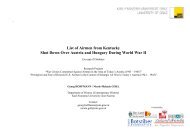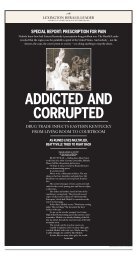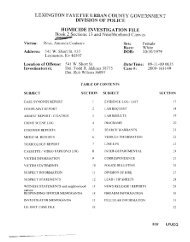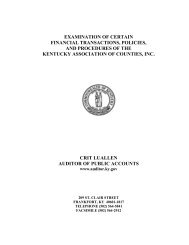Response to motion for summary judgment - Kentucky.com
Response to motion for summary judgment - Kentucky.com
Response to motion for summary judgment - Kentucky.com
You also want an ePaper? Increase the reach of your titles
YUMPU automatically turns print PDFs into web optimized ePapers that Google loves.
officers.’” Combs v. Wilkinson, 315 F.3d 548, 558 (6 th Cir. 2002). For this reason alone, <strong>summary</strong><br />
<strong>judgment</strong> may still be premature with respect <strong>to</strong> Kristine LaFoe, especially <strong>to</strong> the extent the criminal<br />
trial may shed light on how she lied about and covered-up incidents of excessive <strong>for</strong>ce. However,<br />
at this stage of the case, LaFoe has testified that she could have seen officers alone with Gerald in<br />
Cell P-7 but does not remember whether she did. (LaFoe Depo., Ex. 8, p. 57-58).<br />
C. Clarence McCoy and Maria Jones are not entitled <strong>to</strong> <strong>summary</strong> <strong>judgment</strong>.<br />
Whenever prison officials stand accused of using excessive physical <strong>for</strong>ce, 9 the core judicial<br />
inquiry is whether <strong>for</strong>ce was applied in a good faith ef<strong>for</strong>t <strong>to</strong> maintain or res<strong>to</strong>re discipline, or<br />
maliciously and sadistically <strong>to</strong> cause harm. Hudson v. McMillian, 503 U.S. 1, 6-7 (1992).<br />
“Although the maintenance of prison security and discipline may often require that prisoners be<br />
subjected <strong>to</strong> physical contact which at <strong>com</strong>mon law would be actionable as an assault, a violation<br />
of the Eighth Amendment will nevertheless occur if the offending conduct reflects an unnecessary<br />
and wan<strong>to</strong>n infliction of pain.” Pelfrey v. Chambers, 43 F.3d 1034, 1037 (6 th Cir. 1995). In this<br />
case, the question is not whether physical <strong>for</strong>ce was necessary, but whether it occurred at all. If the<br />
prison guards used <strong>for</strong>ce, there is no question but that this use of <strong>for</strong>ce was wan<strong>to</strong>n and unnecessary.<br />
Anthony Estep testified that Gerald Cornett was not uncooperative or <strong>com</strong>bative in any way, and that<br />
Cornett did not say or do anything that deserved any type of physical <strong>to</strong>uching beyond being<br />
pat/frisked. (Estep Depo. at 49). Clarence McCoy also testified that Gerald Cornett did not do<br />
anything <strong>to</strong> give McCoy a reason <strong>to</strong> put his hands on him. (McCoy Depo. at 29-30). “‘If a guard<br />
decided <strong>to</strong> supplement a prisoner’s official punishment by beating him, this would be<br />
9 Although not particularly relevant, it should be noted that Cornett’s claims arise under the Fourteenth<br />
Amendment’s Due Process Clause, as opposed <strong>to</strong> the Eighth Amendment’s Cruel and Unusual Punishment Clause,<br />
because Cornett was a pre-trial detainee. See Leary v. Livings<strong>to</strong>n County, 528 F.3d 438, 443 (6 th Cir. 2008).<br />
34







